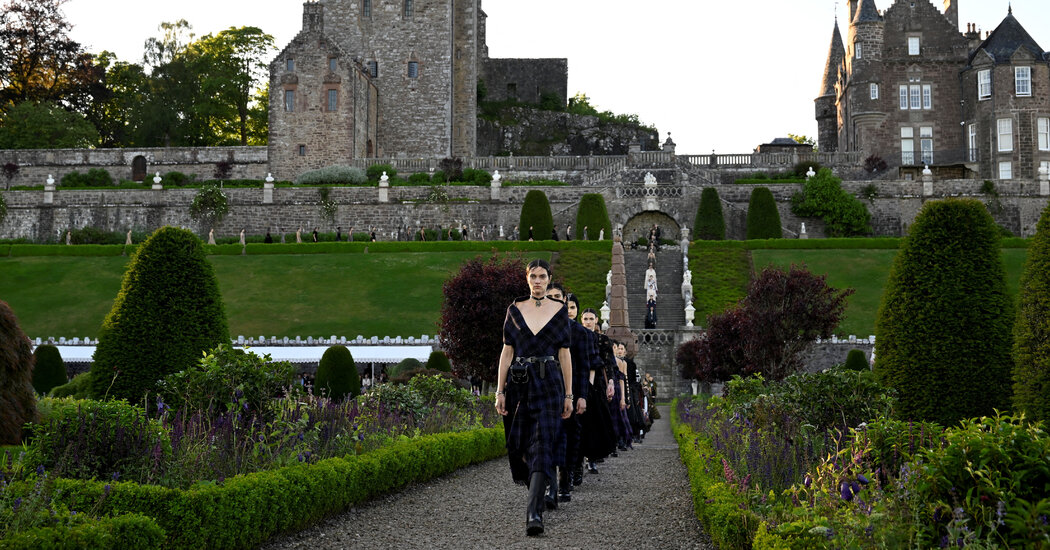When is a fashion show not just a fashion show? If it is a vehicle for cultural diplomacy.
At least this seems to be the case with the cruise (or resort or pre-spring or whatever you want to call them) destination extravaganzas that have taken place over the past month. These events increasingly serve to position the big five brands, which see them less as mere fashion houses and more as national ambassadors to the world: billion-dollar influences on unofficial state visits.
Once upon a time, when this interstitial season was invented to bridge the gap between fall and spring runway shows, cruise collections featured clothes that were more wearable or practical than the designs shown during the regular seasons. Now the clothes (or at least their wearability) are almost irrelevant in the hands of the mega brands. The point is the spectacle, access and power they represent – of all kinds, including celebrity and social media. The stars in the front row are as striking a part of the shows as the shows themselves.
In a world full of micro trends in fashion, that might be the biggest trend of them all.
This was especially the case this season, as the shows of the five major French brands – Chanel, Louis Vuitton, Hermès, Dior and Balenciaga – served as de facto calling cards for the Paris Olympics, which are touted as the most ‘fashionable’ . Olympic Games ever.
It is no coincidence that two of these brands, Louis Vuitton and Dior, are owned by LVMH, a top sponsor of the Olympic Games. That is not the fact Bernard Arnault, the brains of LVMH, has explicitly stated that he doesn’t see his megabrands as selling luxury, but as selling “culture.” And it’s worth noting that this was Balenciaga’s first time exhibiting in China, and Hermès’ first new collection show outside France.
“Hermès has always had a strong bond with New York,” said the brand’s designer Nadège Vanhee, before its New York debut, held at Pier 36 and complete with hanging yellow traffic lights and a Gallic cocktail boîte.
“It’s the same energetic woman taking in the sounds and energy of the city,” Ms. Vanhee continued, though her attire looked more appropriate for someone taking in the city. on, not just inside; the smooth black and caramel-colored leather exuded an active, rather than passive, atmosphere. The brand’s signature scarf prints and fringes were still there, but the overall effect was more haute night crawler than equestrian, right down to the leather newsboy caps. And therefore more attractive.
Fashion, like anything else, has been part of France’s heritage and identity in the world. These shows simply expand the territory.
The travelogue of influence
It started with Chanel in early May, just after the Olympic flame arrived in that port city.
On the roof of the Le Corbusier-designed MAMO, for Kristen Stewart, Tessa Thompson and Lily-Rose Depp, among others, designer Virginie Viard offered a parade of athChaneleisure: long bouclé coats over cycling shorts, tweed skirt suits with hoods and little cocktail dresses with double C brand closures. There was even evening sweating.
The combination of sport and branded semiology was more awkward than inspiring, but at least the lace version of tank top dressing was cool. And the setting was spectacular, even viewed remotely, via livestream, which is how this critic watched, since New York Times reporters don’t accept free trips (most of the media that attend, like the celebrities and some Very important clients, do this as “guests” of the house). Indeed, it was more memorable than the clothes — perhaps a harbinger of Ms. Viard announcing she was leaving the brand a few weeks after the show.
Next was Vuitton, where designer Nicolas Ghesquière continued his quest for time-traveling architectural grandeur in the multi-column Hypostyle Room of Antoni Gaudi’s Park Güell in Barcelona and for Sophie Turner, Cynthia Erivo and the Haim sisters.
There, under a ceiling of mosaic domes, he sent out a parade of wardrobe building blocks with just as much structure. The triangular ’80s jackets with jutting shoulders and precisely angled gaucho hats were strangely galactic, while the evening taffeta puffballs had go-go decade references in their swirls.
Then came Balenciaga, at Shanghai’s Jean Nouvel-designed Museum of Art Pudong, where the city’s jutting skyline served as both a backdrop and a focal point for the equally towering boots that made their way down the runway. Stacked on 7-inch soles, they were made in the shape of skyscrapers, their height allowing for elongated, floor-sweeping trench coats. And that was just the start of the meme-baiting, which continued through trench coat and puffer coat bags (literally slung over the shoulder) and even more duck-billed sneakers.
For a brand that has created a signature by combining show and social commentary, the statement felt less like food for thought than social media fodder. It was also a departure from the power player day silks with bows, fit for an ironic Margaret Thatcher, and the even chicer evening dresses made from upcycled materials.
See, for example, a strapless white look made from Tyvek, a strapless sheath made from gold foil and a pink cotton candy cocoon dress decorated with what looked like feathers (but turned out to be strips of pink plastic garbage bags). In a country where luxury is a topic of increasing tension, it was a clever reflection of the mood.
Castles and Tartans
As artistic director of Dior womenswear, Maria Grazia Chiuri, said before her show, held in the lush gardens of Drummond Castle in Perthshire, Scotland: “I think it is very important to explain that fashion is not just a brand; that fashion is an area where we talk about many different aspects that are political, economic and cultural.”
Hence her decision to dedicate her cruise collections to both highlighting Dior’s global history and combining it with local craftsmanship. This time the focus was on a 1955 collection that Christian Dior showed at Gleneagles, and on the history of Mary, Queen of Scots, and her passion for embroidery and its semiology. Throw in the work of Scottish specialists Harris Tweed; Johnstons of Elgin, the knitwear company; and an independent brand called Le Kilt, founded by thirtysomething Samantha McCoach in 2014 to make kilts contemporary, and you get clan Dior.
The result positions Dior as a tastemaker, bestowing its seal of approval and aura of chic on others, and gives the collections a reason to exist in a world that often seems full of too much stuff. Ms. Chiuri’s interpretation of the local aesthetic can be blindingly banal: Scotland! Tartan! Bagpipes! Argyles! – but it also reflects the curiosity of an outsider.
Sometimes that combination works really well, as with the softer New Look silhouettes made of purple and black tartan shawls and the chainmail evening dresses; sometimes less well, as in the faux-punk postcard pashes of old Dior-in-Edinburgh photos and the cocktail dresses and corsets embroidered with words like ‘bossy’, ‘hysterical’ and ‘whining’. (Ms. Chiuri can’t give up her yen entirely for a feminist slogan.)
One scarf with a map of Scotland on it was so literal you expected a Google Maps dot pointing to the show’s location. But the sheer dedication of 89 such looks ultimately has a sincerity that is undeniable and more interesting than what is often seen in her regular runway shows.
It makes cross-border cooperation look incredibly good.





